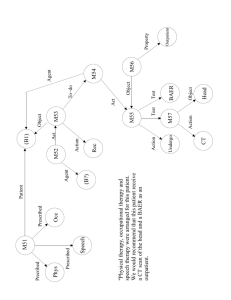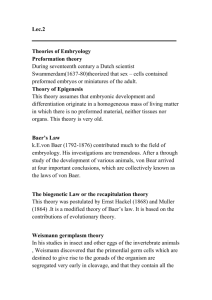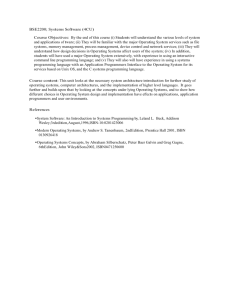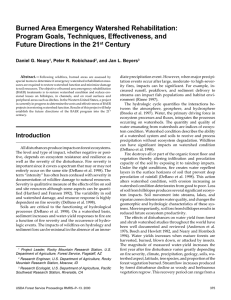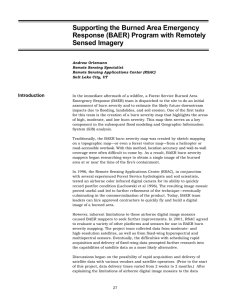Project Title: Project Leader: Participating Research Contacts: Participating Forests/Grassland Contacts:
advertisement
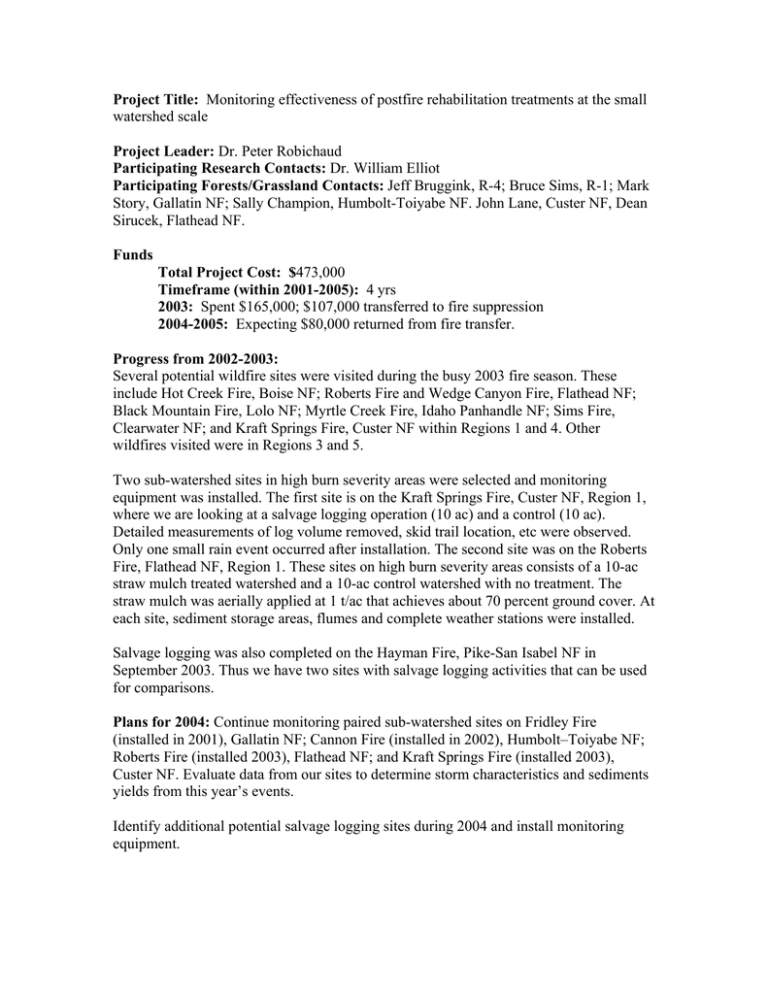
Project Title: Monitoring effectiveness of postfire rehabilitation treatments at the small watershed scale Project Leader: Dr. Peter Robichaud Participating Research Contacts: Dr. William Elliot Participating Forests/Grassland Contacts: Jeff Bruggink, R-4; Bruce Sims, R-1; Mark Story, Gallatin NF; Sally Champion, Humbolt-Toiyabe NF. John Lane, Custer NF, Dean Sirucek, Flathead NF. Funds Total Project Cost: $473,000 Timeframe (within 2001-2005): 4 yrs 2003: Spent $165,000; $107,000 transferred to fire suppression 2004-2005: Expecting $80,000 returned from fire transfer. Progress from 2002-2003: Several potential wildfire sites were visited during the busy 2003 fire season. These include Hot Creek Fire, Boise NF; Roberts Fire and Wedge Canyon Fire, Flathead NF; Black Mountain Fire, Lolo NF; Myrtle Creek Fire, Idaho Panhandle NF; Sims Fire, Clearwater NF; and Kraft Springs Fire, Custer NF within Regions 1 and 4. Other wildfires visited were in Regions 3 and 5. Two sub-watershed sites in high burn severity areas were selected and monitoring equipment was installed. The first site is on the Kraft Springs Fire, Custer NF, Region 1, where we are looking at a salvage logging operation (10 ac) and a control (10 ac). Detailed measurements of log volume removed, skid trail location, etc were observed. Only one small rain event occurred after installation. The second site was on the Roberts Fire, Flathead NF, Region 1. These sites on high burn severity areas consists of a 10-ac straw mulch treated watershed and a 10-ac control watershed with no treatment. The straw mulch was aerially applied at 1 t/ac that achieves about 70 percent ground cover. At each site, sediment storage areas, flumes and complete weather stations were installed. Salvage logging was also completed on the Hayman Fire, Pike-San Isabel NF in September 2003. Thus we have two sites with salvage logging activities that can be used for comparisons. Plans for 2004: Continue monitoring paired sub-watershed sites on Fridley Fire (installed in 2001), Gallatin NF; Cannon Fire (installed in 2002), Humbolt–Toiyabe NF; Roberts Fire (installed 2003), Flathead NF; and Kraft Springs Fire (installed 2003), Custer NF. Evaluate data from our sites to determine storm characteristics and sediments yields from this year’s events. Identify additional potential salvage logging sites during 2004 and install monitoring equipment. Products and/or tech transfer expected in 2004: Informally disseminate monitoring results to BAER teams and Forest personnel as data become available. Present current results at regional workshop and national BAER training as well as several professional national meetings. The new BAER web site has data on BAER treatment effectiveness (http://fsweb.gsc.wo.fs.fed.us/baer/index.html) that was collected during the review of the BAER program and existing knowledge of treatment effectiveness. Weather and runoff data is updated daily and is available on our web page at http://forest.moscowfsl.wsu.edu/engr/weather. Write summaries of treatment effectiveness to date. Data collected from these paired watersheds are being used to validate our modeling efforts. Our most recent erosion prediction tool, Erosion Risk Management Tool (ERMiT) provides probabilities of erosion in the first 4 years after a wildfire and the effects of various BAER treatments. Beta versions were used in the 2003 fire season with full implementation expected for 2004. Issues that need discussion with the R1/R4/RMRS Steering Group?: Will adequate funds be returned from fire transfer to complete the studies? Can approval for salvage logging operations be expedited?
